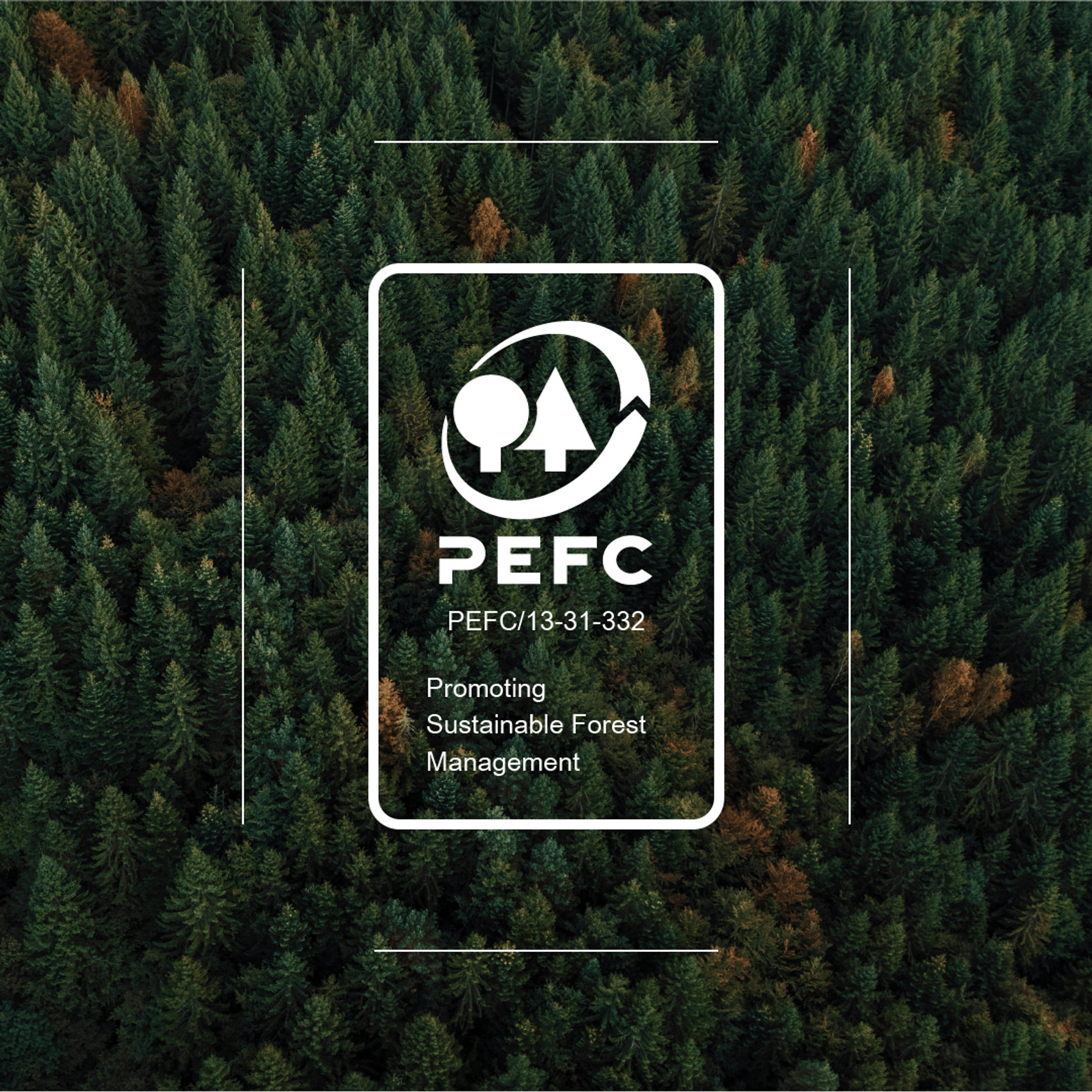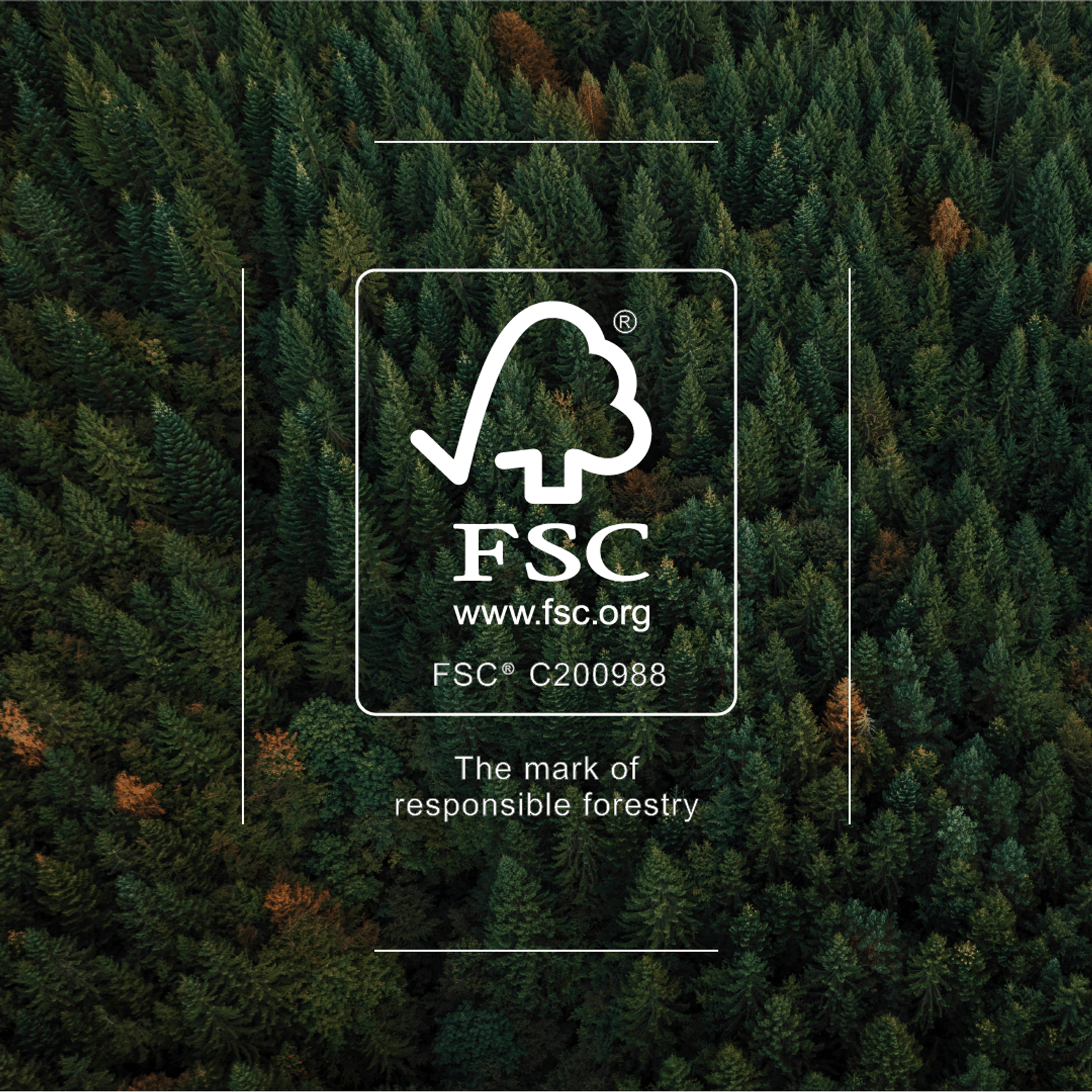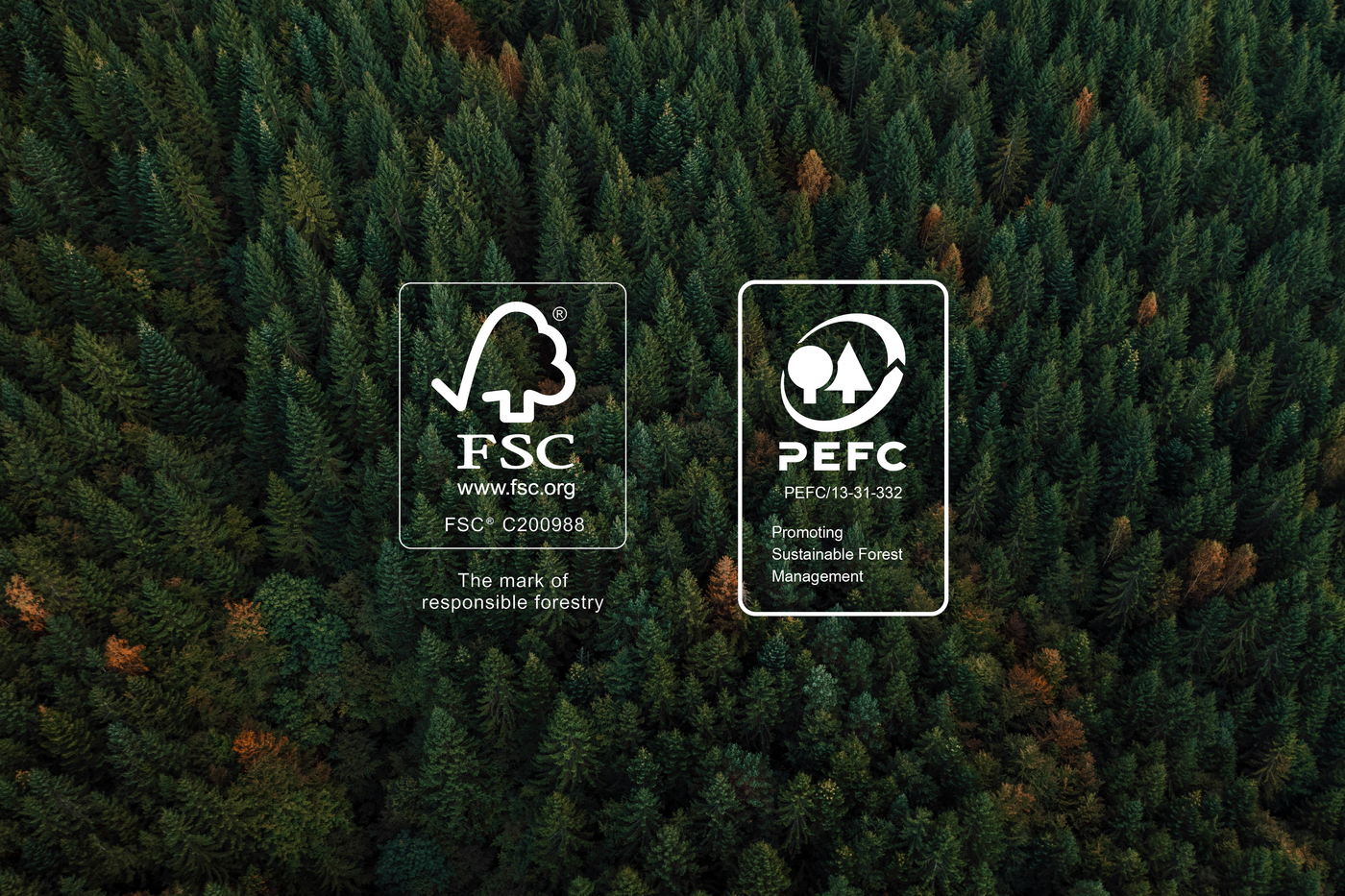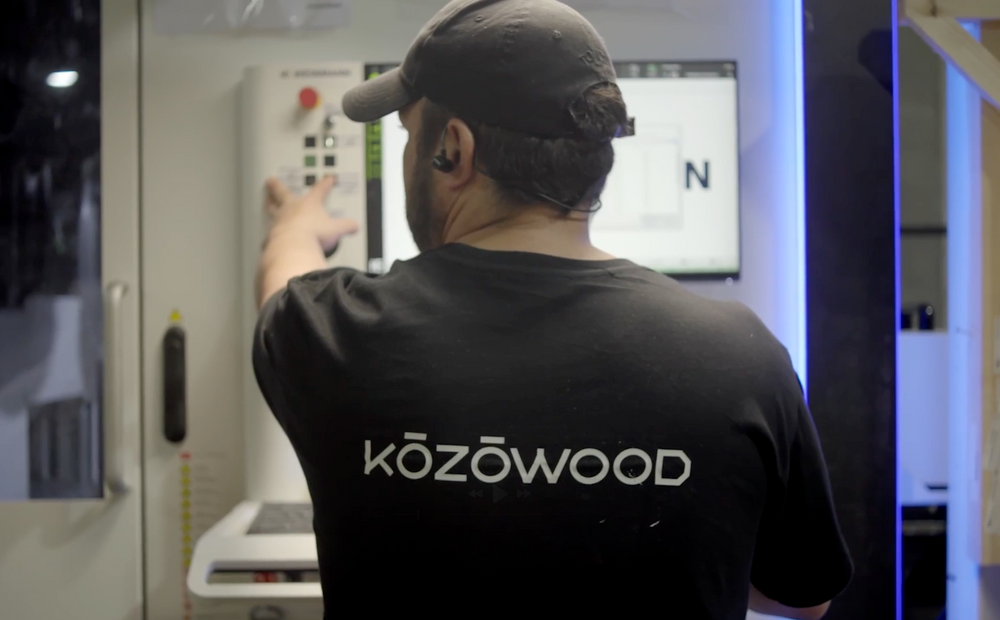(01)
Introduction
In the last decade, Kōzōwood Industries has emerged as a pioneer in the timber construction industry in Portugal, offering high-quality solutions under the Kōzōwood and Ooty brands. Specializing in wooden house construction, we distinguish ourselves not only through our innovative approach but also through our dedication to sustainability and quality in every project.
Kōzōwood's commitment to ensuring sustainability and excellence in forest management is demonstrated by its respective PEFC (Programme for the Endorsement of Forest Certification) and FSC® (Forest Stewardship Council) certifications. These certifications reflect the environmental responsibility and commitment to preserving natural resources.
By employing innovative techniques such as (Cross-Laminated Timber), we ensure the longevity and aesthetics of our projects while ensuring that every piece of wood used comes from sustainable sources. The use of FSC®-certified wood and derivatives in our residential projects not only attests to the quality of our products but also underscores our commitment to sustainable forest management.
At Kōzōwood Industries, every architectural project is conceived with profound respect for the environment. Our commitment to sustainability goes beyond certifications—it's a philosophy integrated into every phase of the construction process.
Throughout this article, we will explore how PEFC and FSC® certifications ensure sustainability and quality in all Kōzōwood Industries projects, demonstrating our ongoing commitment to excellence and environmental responsibility.
(02)
PEFC Certification
What is PEFC Certification?
PEFC is a major advocate for promoting sustainable forest management practices worldwide. It supports national forest certification systems, ensuring that products with raw materials from the forest, such as wood and cork, are ethically and sustainably manufactured with a focus on social responsibility.
PEFC certification is tailored to the unique needs of each country, developed with input from various entities, including forest owners, NGOs, unions, businesses, and associations. This certification system recognizes the unique environmental and social characteristics present in different regions of the globe.
Let's now look at how Chain of Custody (CoC) certification works. The CoC certification process involves tracking certified raw materials throughout the supply chain. Thus, when a product with a PEFC label is purchased, there is assurance that it originated from a sustainably managed forest with the same certification.
PEFC certification is not just for large producers. In fact, small and family-owned forest companies also have the opportunity to benefit. Recently, a new feature with potential has been added: the Data Disclosure System (DDS). This feature requires entities to share information regarding the origin and species of forest-origin materials, contributing to greater transparency and accountability throughout the supply chain.
The presence of a PEFC logo on a wood product signifies that its producers are playing a crucial role in protecting the world's forests.

PEFC Certification
Image by Kozowood Industries
(03)
FSC® Certification
What is FSC® Certification?
Being certified by FSC® means that forest activities must comply with ten key principles covering all aspects, from preserving high conservation values to promoting good relations with local communities, respecting workers' rights, and carefully monitoring the environmental and social impacts of their work. If a forest is certified by FSC®, you can bet it's being managed according to the highest environmental, social, and economic standards.
But FSC® doesn't stop there—it also has a chain of custody certification. This ensures that any material certified by FSC® is kept separate from uncertified ones as it travels from the forest to the market. Therefore, if a company wants to put an FSC® label on its products and sell them as FSC®-certified, it needs to be certified by this entity itself.
FSC®'s mission is clear: they want to promote responsible forest management worldwide, ensuring that everyone has fair access to the benefits of FSC systems while maintaining the integrity, credibility, and transparency of the system. They are also interested in creating commercial value for products from FSC-certified forests and strengthening their global network to achieve these goals.
When you see the FSC® logo on a product, it means the product comes from responsible sources and supports environmentally friendly, socially beneficial, and economically viable forestry, You'll find the FSC® label on all kinds of products, from paper, wood, and furniture to medicines and even jewelry, giving consumers the opportunity to support the environment.

Certificação FSC®
Image by Kozowood Industries
(04)
Advantages of PEFC and FSC® Certifications
Benefits of PEFC and FSC® Certifications for the Environment and Society
PEFC and FSC® certifications are essential tools for ensuring responsible forest management and promoting sustainable business practices, bringing benefits to both the environment and society. These certifications not only encourage the procurement of sustainable products but also ensure compliance with the law and commitment to responsible forestry.
PEFC Certification Advantages
- PEFC certification highlights sustainable purchasing choices.
- It helps demonstrate a company's commitment to sustainability and the UN's Sustainable Development Goals.
- Products with PEFC certification can display the PEFC label, providing customers with proof of sustainability.
- It reflects compliance with the fundamental conventions of the International Labour Organization, protecting the rights of people in the forest and throughout the forest supply chain.
- PEFC certification for sustainable forest management ensures that forests are managed in accordance with rigorous environmental, social, and economic requirements, creating value for workers and communities.
- PEFC-certified products originate from forests managed in compliance with national and international legal requirements.
- The purchase and sale of PEFC-certified products contribute to sustainable forestry towards the SDGs.
- PEFC certification provides proof of traceability.
FSC® Certification Advantages
- FSC® certification promotes responsible harvesting methods.
- FSC® is the most reliable and recognized forest certification system in the world.
- FSC® is an independent, member-led group that ensures diversity of perspectives in decision-making.
- FSC® certification requires organizations to apply FSC®'s fundamental labor requirements to their certified activities.
- FSC® requires forest managers to engage with local community members and protect the cultural rights of indigenous peoples.
- FSC® certification ensures compliance with laws and respect for traditional land rights.
- FSC® certification allows access to markets that require or prefer certified products.
- FSC®'s forest management standards expand protection of water quality, prohibit the exploitation of rare old-growth forests, prevent loss of natural forest cover, and prohibit the use of highly hazardous chemicals.
- FSC® certification promotes the maintenance of demanding social values.
- FSC® certification promotes the development and implementation of forest management plans in accordance with international standards.
(05)
Kōzōwood Projects
Impact of PEFC and FSC® Certifications on Kōzōwood Projects
In today's business landscape, one of the main factors for companies to distinguish themselves and strengthen their market presence is through the certification of their processes and products. Kōzōwood Industries' certifications are not just a seal of approval; they are also a strategic asset that propels the company towards excellence. Here are some positive impacts of PEFC and FSC® certification on Kōzōwood Industries projects:
1. Consumer Confidence:
PEFC and FSC® certifications demonstrate our commitment to sustainable practices. Thanks to these credentials, a trusted environment is cultivated with customers who prioritize sustainability, allowing them to feel more secure when purchasing products from certified sources.
2. Improvement of Business Processes:
By ensuring that all materials comply with sustainability standards, these certifications can contribute to optimizing supply chain management systems. Additionally, they play a crucial role in mitigating operational risks associated with sourcing raw materials from uncertified forests, which are often linked to environmental or social controversies.
3. Company Reputation and Brand Equity:
Companies that embrace these certification systems enjoy greater credibility and trust with customers. Moreover, they gain a significant competitive advantage by differentiating their offerings from uncertified competitors, which can boost their position in the market.
4. Legal Compliance Benefits:
The certifications ensure compliance with various international and national laws. Additionally, they guarantee improvement in working conditions within companies and protect the rights of workers, both within the organization and in their supply chain. This approach not only promotes a fair and safe working environment but also strengthens the company's relationship with its stakeholders and consumers.
In summary, while certifications demonstrate Kozowood Industries' dedication to sustainable practices, their true impact lies in how these practices can improve the company's operations and its relationship with the environment and consumers.
(06)
F.A.Q - Frequently Asked Questions?
What is Timber Frame?
Timber Frame is an ancient construction technique using timber framing. Building structures with this technique involves constructing frameworks using precisely fitted and interconnected timber pieces, with joints secured by wooden dowels.
In simple terms, Timber Frame construction uses wooden beams in the exterior structural wall to support imposed loads before transferring them to the foundations. Timber frame constructions include walls, floors, and roofs, designed as a single, cohesive structure.
Timber frame construction is gaining popularity due to its numerous advantages. One of the main benefits is that timber structures, unlike traditional concrete-framed houses, allow construction to begin off-site, speeding up the pace of work.
You can find out more in this article: CLT & Timber Frame: Discover the Main Differences
What is CLT?
Cross-laminated timber (CLT) panels consist of layers of wood boards stacked in crosswise patterns (usually three, five, or seven layers) and glued together. Finger joints and glue hold these lamellas together. This configuration allows the panel to achieve improved structural stiffness in all directions. Panels can be manufactured in standard sizes or custom dimensions tailored to the customer's needs or project, although their length is limited due to transportation constraints. One of the great advantages of CLT construction is its ability to build vertically, representing an innovative method in architecture due to the design freedom of this construction technique. Mass Timber, characterized by its robustness, adaptability, and ecological attributes, has become a popular choice for high-rise construction. Skyscrapers built with CLT not only exhibit structural integrity but also demonstrate sustainability characteristics. The incorporation of Mass Timber in the construction of buildings is gradually expanding, with the next era of architecture witnessing an increase in the number of buildings constructed using CLT, potentially altering our perception of housing and contributing to environmental conservation.
You can find out more in this article: CLT & Timber Frame: Discover the Main Differences

